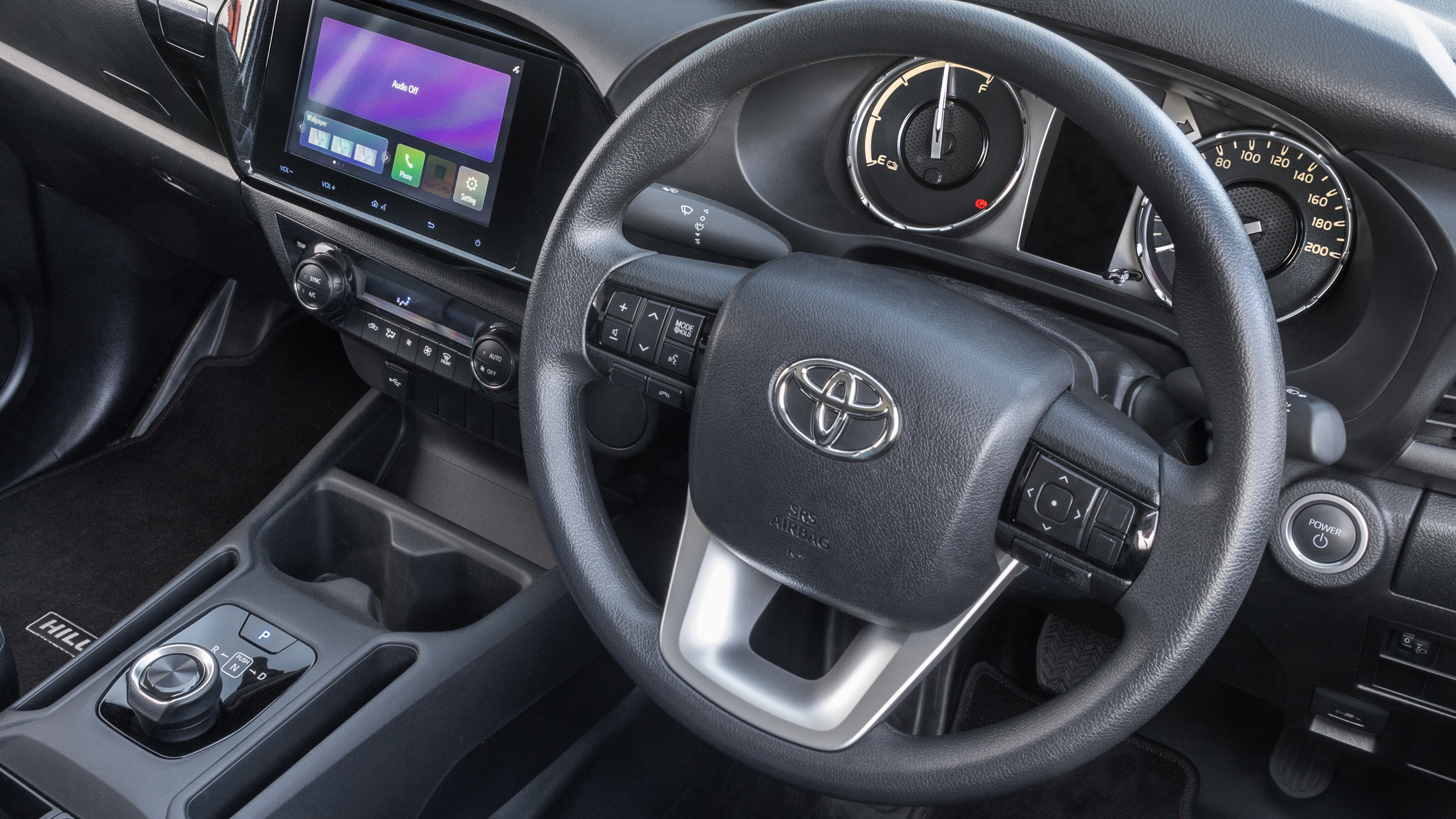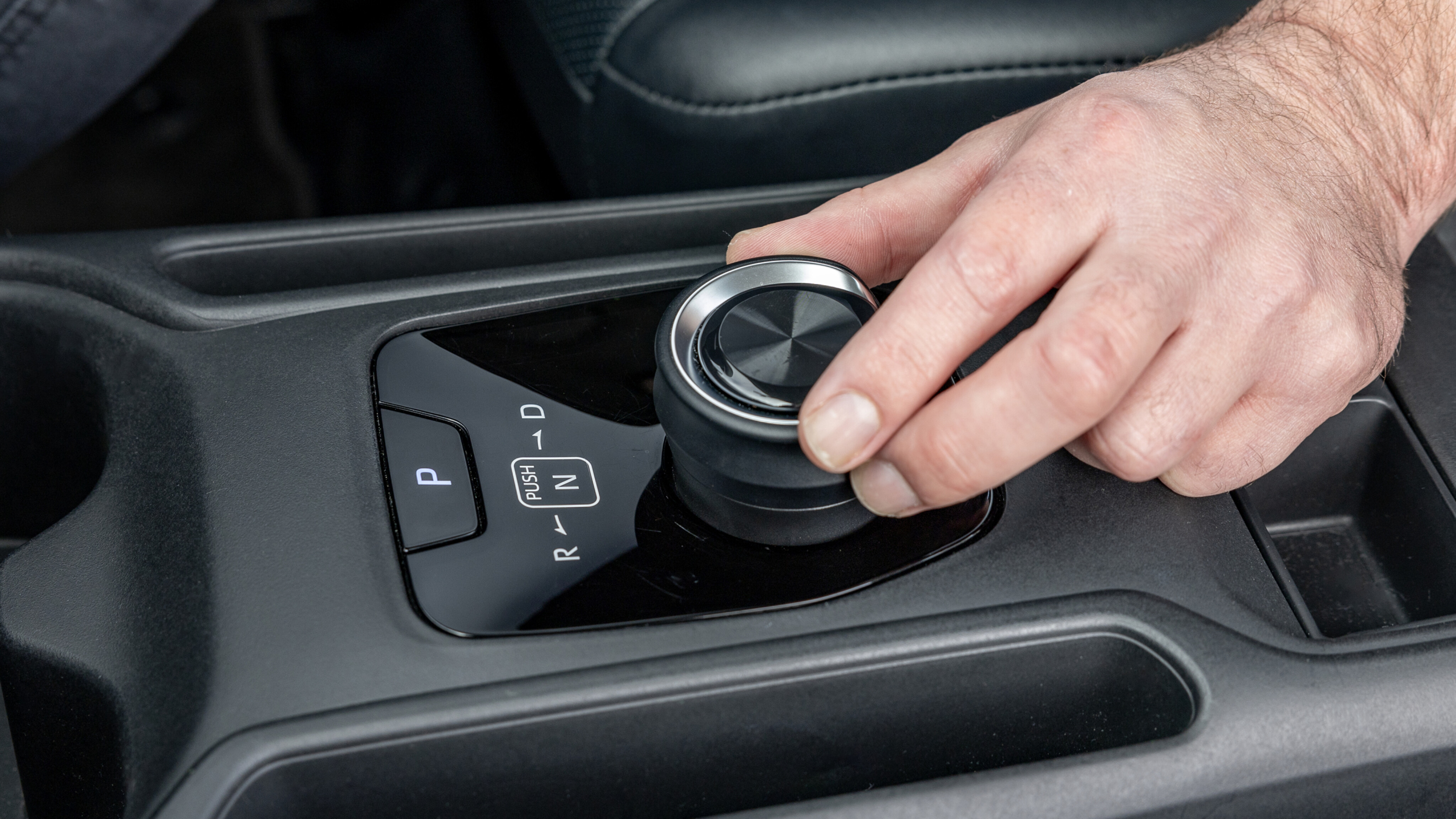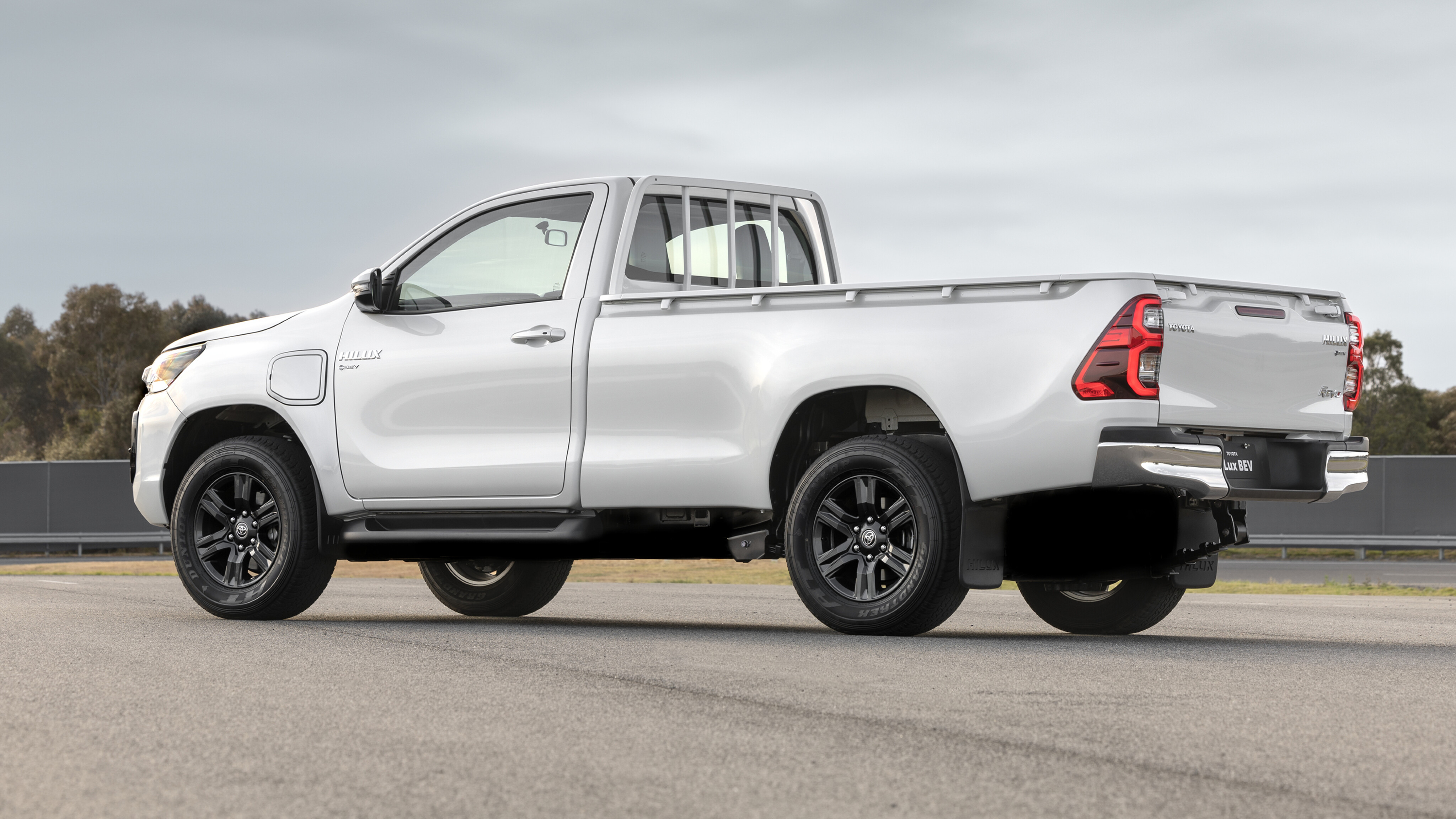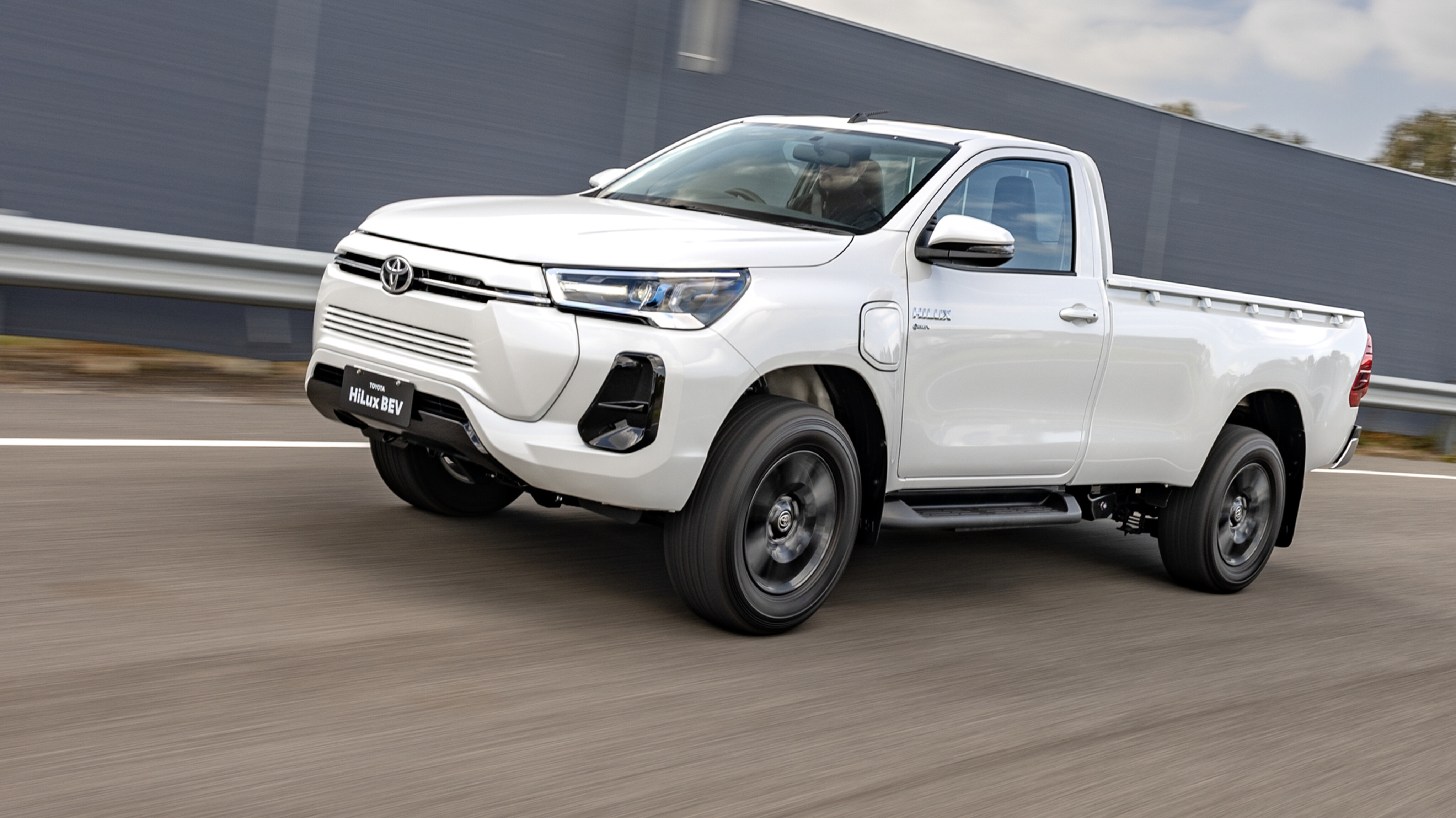
In August this year, mysterious grainy pictures from an after-dark dock in Western Australia revealed an electric Toyota Hilux arriving on Australian soil.
Soon after, it was confirmed to be the same Hilux Revo BEV concept created by Toyota Thailand to mark 60 years of the big T.
Now though, the intriguing zero-emissions ute is doing the rounds in Australia for ‘internal review’ purposes, says its steward Toyota Australia.
However, the local team has pored over the vehicle and now it's been handed over for a little external review, with a precious few laps of the private test track at the Melbourne headquarters in the hands of the media. That's us.
If you’ve ever spent any time in or around concept vehicles, you’ll know that for every cool design signature and vivid paint colour, there’s a trim being held on with chewing gum or a panel gap like the Corinth Canal.
Not the Revo BEV though.
On first inspection its pearl white paint is well finished, the LED headlights with cool blue inserts are still in one piece, and the ventless grille appears to be a production part.
It’s the same story with the ‘oily’ bits too. Photography of the rear axle and underside of the chassis was not allowed, but we can say that what we saw during a dive under the BEV was a single drive motor integrated into the De Dion rear axle, rear leaf springs and a battery pack carefully fashioned to fit within the legs of an apparently standard ladder chassis. It all looked exceptionally well-engineered and typically Toyota.

The HiLux Revo BEV's maker isn't specifying a lot of hard facts and figures, including battery size, but with a reported range of ‘about 200km’ we’d estimate the unit to be about the 55kWh mark.
What was completely off-limits was what lies under the bonnet, presumably to protect a serious amount of IP and where we suspect the power management electronics and inverter are hiding.
It’s not known if Toyota collaborated with any other brands on the development of the Revo BEV, but a glimpse under the hood might reveal if any of Subaru’s hardware is involved, which would continue the collaboration forged with the Toyota BZ4X and Subaru Solterra project.
The Hilux’s gear selector serves as a clue – it's the same rotary controller used in the pair of fraternal-twin electric SUV models.

Driving the ‘concept’ is an interestingly paradoxical experience.
In one way, the Revo feels exactly like a HiLux with utilitarian interior, commercial driving position, durable (if a little dull) interior materials, and generally familiar feel.
However, press the accelerator and this particular version sneaks away from stationary in eerie silence. Acceleration is not incendiary but the typical linear thrust of electric drive makes it feel faster than it probably claims zero-to-100km/h dashing – another figure not yet publicised.

It feels exactly like a regular HiLux, but press the accelerator and this particular version sneaks away from stationary in eerie silence
There’s a little electric whine in report of full acceleration and the throttle calibration has been fine tuned - again, this does not feel like some show pony hastily bolted together for the sake of a marketing or photo opportunity.
What leaves even more of an impression is the handling. No Hilux turns-in with as much eagerness as this engineering study and the weight distribution appears to be midship if not a little rearward.

There’s still some classic HiLux roll as the speed increases in corners, and gip is good despite tyres that appear to have endured some torture and have definitely seen better days, but the drive experience isn’t without reward.
Only a handful of test-track surface imperfections hint at a very similar ride quality to regular HiLux variants and, the steering is also decidedly familiar.
The Revo BEV feels exactly like a HiLux but simultaneously, nothing like a HiLux.
Other intriguing interior clues include a steering column cowl which, unlike virtually every other part, appears to be very much prototyped and 3D printed with a charge or proximity RFID symbol embossed on the top side. Hmmm…

And then there’s the central digital information display nestled between analogue dials – nothing new to a HiLux you’d say – except for one of its screens, which indicates the proportion of available electrical power that’s being used as the accelerator is pressed.
There’s also a ‘charge’ portion which indicates the amount of regenerative braking that’s being performed on overrun too. This wouldn’t be quite so revealing if the concept wasn’t capable of re-gen braking, rendering the lower portion of the digital dial superfluous … for now.
To our minds this is a clear sign a version of the HiLux Revo BEV will follow that does offer the completed drivetrain, including regenerative braking and perhaps a longer range as a result.

Well, one already has been all but confirmed. In the concept’s native Thailand, a small fleet of ‘production’ Revo BEV versions will roll out in a taxi trial.
We’re not talking limo transport here, but rather the almost inconceivable public transport option offered in Thailand where the tray of a ute is converted into a pair of longitudinal bench seats to accommodate up to 12, plus another couple of passengers riding freestyle on the rear step.
Toyota is yet to speak of a production electric HiLux for Australia, but don’t for a second expect something like this.
So what could the concept spawn?
And would a production version similar to the one we drove be the perfect electric ute for Australia?
Perhaps not. Firstly, it’s a single-cab to maximise the tray space whereas the dual-cab reigns supreme Down Under.
Secondly, it’s rear-wheel-drive and Aussies are obsessed with all-wheelers when it comes to the work horse.
And, finally, its relatively modest circa-200km range would be slashed if a trailer was hooked up – another of the nation’s favourite automotive habits.
But while the concept wouldn’t make much sense in the outback and bush trails of Australia’s country, there is one place it does make more sense.
Earlier this year, Toyota signed an MoU with mining giant BHP for “lowering vehicle operation emissions” and specifically “safety in light vehicle design”. You’d be hard pressed to find a better vehicle to achieve that than a production model based on the concept seen here.
And if Toyota is gearing up to introduce its first battery powered HiLux to Thailand, Australia and the rest of the world in single-cab, rear-drive variety, you can expect more versions to follow…



COMMENTS